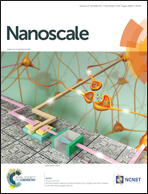High-strength carbon nanotube/carbon composite fibers via chemical vapor infiltration†
Abstract
In this study, we have developed an efficient and scalable method for improving the mechanical properties of carbon nanotube (CNT) fibers. The mechanical properties of as-synthesized CNT fibers are primarily limited by their porous structures and the weak bonding between adjacent CNTs. These result in inefficient load transfer, leading to low tensile strength and modulus. In order to overcome these limitations, we have adopted chemical vapor infiltration (CVI) to efficiently fill the internal voids of the CNT fibers with carbon species which are thermally decomposed from gas phase hydrocarbon. Through the optimization of the processing time, temperature, and gas flow velocity, we have confirmed that carbon species formed by the thermal decomposition of acetylene (C2H2) gas successfully infiltrated into porous CNT fibers and densified them at relatively low temperatures (650–750 °C). As a result, after CVI processing of the as-synthesized CNT fibers under optimum conditions, the tensile strength and modulus increased from 0.6 GPa to 1.7 GPa and from 25 GPa to 127 GPa, respectively. The CVI technique, combined with the direct spinning of CNT fibers, can open up a route to the fast and scalable fabrication of high performance CNT/C composite fibers. In addition, the CVI technique is a platform technology that can be easily adapted into other nano-carbon based yarn-like fibers such as graphene fibers.


 Please wait while we load your content...
Please wait while we load your content...